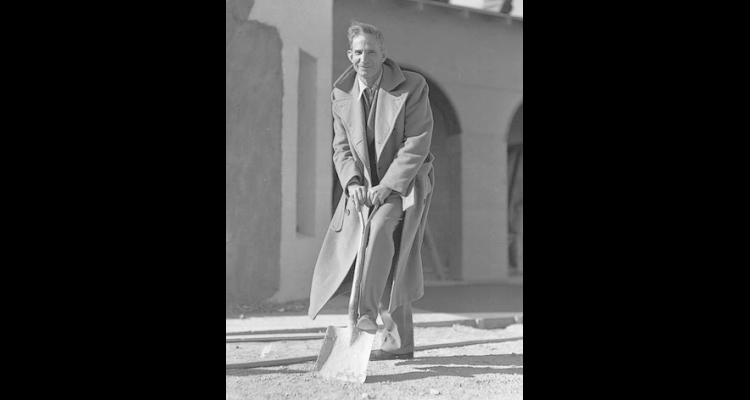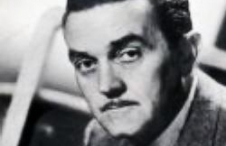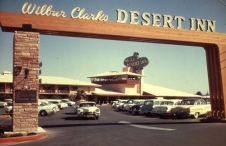Guy McAfee
Born in Winfield, Kansas, in 1888, Guy McAfee eventually joined the Los Angeles Police Department. He rose to the rank of vice squad captain in his twenties and became acquainted with the proprietors of nightclubs, illegal gambling operations, and brothels.
McAfee eventually decided he could make more money in vice and left the police department to run nightclubs. By the 1920s, while liquor was banned during Prohibition, he established himself as a businessman on the Sunset Strip in West Los Angeles, a nightclub district where illegal alcohol was served discreetly.
McAfee arrived in Las Vegas in 1930 when the city licensed him to run a business with legal gambling, which was then restricted to non-bank games such as poker in low-key, saloon-style clubs. But, hJ. Edgar Hoover e told a Las Vegas newspaper reporter years later, he decided the town was not yet ready to support the larger kind of club he wanted to operate.
In 1931, McAfee drew headlines in Southern California and Las Vegas when he was briefly detained in Los Angeles following the murder of two rival businessmen who had been shot by a candidate for office whom McAfee had supported. McAfee denied any involvement and was never charged.
McAfee's Clover Club, a private, illicit casino on the Sunset Strip, was popular with wealthy patrons and the movie crowd in the 1930s. The club was fitted with illegal gambling tables that could be flipped over and hidden during raids. But it didn't always work—police once found a half dozen roulette tables in one raid, along with 300 people in the casino.
In 1938, after grand jury investigations into local crime, Los Angelenos recalled Mayor Frank Shaw. His replacement, Fletcher Bowron, promised to rid the Sunset Strip of gambling and other vice. Newspapers reported FBI director J. Edgar Hoover and U.S. Attorney General Frank Murphy questioned McAfee about crime there in 1939.
That year, McAfee left for Las Vegas with his wife, former film actress June Brewster. He later insisted he moved because he wanted to, and not as the result of political pressure. Soon he acquired the Pair-O-Dice Nightclub and Casino on Highway 91, several miles west of downtown Las Vegas (now occupied by the Frontier). He paid about $20,000 for it. By then, he reportedly held $1 million in assets from California.
Less than a decade after moving to Las Vegas, McAfee was the city's veritable gambling kingpin, mostly on Fremont Street. Unlike California, Nevada had permitted licensed gambling since 1931. McAfee saw Las Vegas as a place to put his experience as an illegal casino operator to legal use.
But McAfee's reputation preceded him. Nevada's governor Edward P. Carville called Clark County District Attorney Roland Wiley and declared that someone of McAfee's infamy should not run a Nevada casino. Wiley's response, which was typical of the time, was that he could do nothing because McAfee's illegal gambling activities in California were legal in Nevada.
McAfee believed his new club would succeed because motorists from southern California, a market he knew, would use the highway and stop in Las Vegas. He expected to attract some of the same well-heeled people who gambled at his backroom club in Los Angeles. McAfee liked to tell others he foresaw a string of clubs and casinos someday opening alongside his place on the highway. Most historians credit him as the first to nickname the area “the Strip” after the Sunset Strip.
McAfee renamed his casino the 91 Club—after the highway—and invested in refurbishing and improving the old Pair-O-Dice to meet the opulent standards of southern California clubs. McAfee also bought a two-story building at 113 Fremont Street with plans to put a gaming club on the first floor and office suites on the second.
Ria Langham, actor Clark Gable's wife, had arrived in January 1939 to begin divorce proceedings. While Langham was in Las Vegas, McAfee opened the 91 Club to capitalize on the national media spotlight on her divorce from Gable.
In 1940, McAfee turned his attention downtown, which already had a number of established casinos. He started the Frontier Club, a small casino, at his Fremont Street property. Next door, McAfee built the Mandalay Lounge nightclub with a South Seas theme and a storm-weathered, wooden dock-like façade and bamboo rails leading up a ramp to the entrance. McAfee's Mandalay served tropical drinks and had an interior feature unique to the town, especially for 1940—a simulated “tropical storm” with raindrops falling amid faux lightning and thunder that patrons could watch from booths and a forty-five-foot bar.
In April 1941, the Strip's first resort, the El Rancho Vegas, opened a mile north of the 91 Club on Highway 91. Later that year, R.E. Griffith, a movie theater chain owner from Texas, arrived in Las Vegas with his nephew, William J. “Bill” Moore. Griffith wanted McAfee's Strip property for a resort to compete with the El Rancho. McAfee sold the 91 Club and its adjacent auto park to Griffith for $35,000, about $15,000 more than he paid for the Pair-O-Dice. Griffith and Moore soon converted McAfee's club into a large bar called the Carillo Room, and debuted the Strip's second resort, the Last Frontier, in 1942.
That year, McAfee bought the Pioneer Club on Fremont. In 1945, he acquired the SS Rex, later renamed Benny Binion's Horseshoe. Still known in Hollywood, McAfee convinced film idols such as William Powell and Cary Grant to come to Las Vegas to see his casinos.
McAfee embarked on a major downtown project in 1945. He took over a former coffee shop and pool hall at 125 Fremont Street to make room for a casino he dubbed the Golden Nugget Saloon. For added space, he acquired the old Boulder Drug Store around the corner on First Street. With $250,000 to spend, he planned to decorate the saloon and casino with items at least fifty-years-old—except for the neon. He ordered Victorian-era woodwork, imported Italian marble and a 120-ton air conditioning system.
In 1946, McAfee opened the Golden Nugget with a décor based on the nineteenth-century Barbary Coast era in San Francisco. It was the finest gaming hall downtown, an area nicknamed “Glitter Gulch.” The Golden Nugget's casino was the largest in Las Vegas at the time. In 1949, McAfee built a 100-foot high neon sign and proclaimed the Golden Nugget “the brightest nightspot in the world.”
In 1951, McAfee and two partners in the Golden Nugget, Jake Kozloff and Beldon Katelman, bought the Last Frontier on the growing Strip for $5.5 million. The resort by then included an outdoor Old West-style attraction, the Last Frontier Village, and the Silver Slipper Nightclub and Casino. McAfee and Kozloff renamed the resort the Frontier. They sold it to Los Angeles businessmen Maurice Friedman and Irv Leff, and their partners in 1955.
McAfee died in Las Vegas on February 20, 1960, at age 71.
Article Locations
Related Articles
Further Reading
None at this time.



